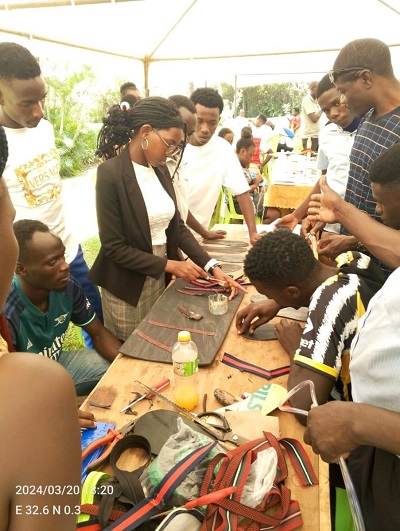
The art workshop offered opportunities to students to encounter with the unusual processes of art making and how to merge indigenous techniques of art making with the contemporary
ART | DOMINIC MUWANGUNZI | The discipline of art requires practical skills more than anything else. Practical skills form the spine of any type of artistic practice in the visual arts including, painting, sculpture, installation art and photography. It is upon this fact that university dons are increasingly creating interventions for their students to tap into the knowledge of established artists and artisans to enable the former acquire the expertise in studio production and innovation that will pave way for their successful career in art. The recent seminar dubbed Capacity Building Workshop, organized by Newcastle University, UK, Uganda Community Art Skill Development and Recycling (UCASDR) and Lilian Nabulime Foundation, was designed to realize the above objectives through establishing synergies between budding artists and artisans working in the local community.
The notion of particularly working with artisans rather than artists did not solely premise itself on the promotion of one of the prime functions of the university that evolves seeking engagements and exchanges with the local community within the scope of community out-reach program. It however also, singularly sought to identify the benefits of thinking outside box through exposing the students to the unusual methods of learning. Artisans by their nature are informally trained in their respective trades and therefore possess unique creative approaches to their artistic productions. An attempt to link them to the learners definitely opens a new window into the different creative processes of art production.
It is through this unfamiliar form of working by the artisans that the students were hooked on. A blacksmith showcasing his rudimentary but ingenious work process that culminates into the production of different hand tools used in the production of sculptural works, prompted a myriad of questions and later conversations among the learners about this indigenous trade that goes back hundreds of years ago among the Baganda of central Uganda. Beyond offering an alternative of affordable hardware tools used in different fields, blacksmithing underscores, though delicately, the aspect of innovation.
The blacksmith, a 72-year-old man, explains that the installation uses a fan belt to inhale and exhale the air which process consequently leads to the production of a furnace that melts the different types of metals. After the metals are placed in the furnace, they can easily be manipulated in any form, size and dimensions. The hand-made kiln, is a remarkable innovation because it is obviously inexpensive to construct, maintain and flexible to use anywhere. The flexible nature of the kiln plus the ingenious characteristic of the blacksmith reflect essential attributes budding artists need to possess to excel in an increasingly competitive art world.
A similar benefit was shared through the engagement with other artisans including broom makers, hand bag and shoe makers and Television aerial manufacturers. The common trait among these group of informal traders is providing an affordable alternative to the already existing expensive utilitarian objects. Equally, these respective trades emphasize the use of found objects in their productions for example, the T.V aerial manufacturer uses aluminum wires and wood which he creatively manipulates into different designs to create an analog aerial. These aerials are mostly popular in locales where poor reception of Television network is common. Therefore, this ingenuity by the artisan is partly motivated by the urgency to be a problem solver in the community he lives in. This aspect of creativity has been severally advocated for by certain groups of art scholars who argue that a real artist should be able to solve the problems of his immediate community.
The workshop with its theme of interaction, exchange and collaboration was a timely intervention that brought together different groups of creatives- formal and informal- into one space. Their interaction and exchange symbolized how each group can learn from the other irrespective of social background, gender and education levels. As such, in spite of the stereotypes that may be harboured about artisans and the simplistic definition of their practice as craft, these creatives deserve a seat at the high table of artists because their work prompts deep conversations about the different indigenous art making techniques and how some of these crafts have been able to integrate the traditional and contemporary their respective designs. Therefore, now maybe the time to integrate such a workshop into a complete course unit where such practical learning is formally recognized. This will help to empower, enlighten and boast the creative processes of both learners and artisans.
****
Students who participated in the workshop were first, second and third year students of Visual Arts from Margaret Trowel School of Industrial and Fine art, Makerere.
 The Independent Uganda: You get the Truth we Pay the Price
The Independent Uganda: You get the Truth we Pay the Price


